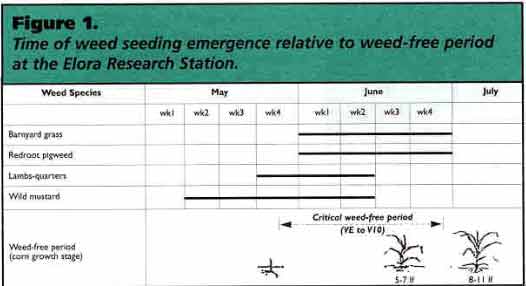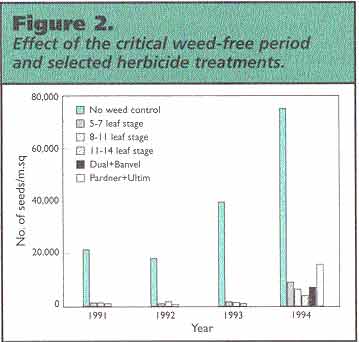
Do Late Emerging Weed Escapes
Risk Future Weed Management?
All weeds are not equal. Weeds emerging with the crop are those that cause greatest yield loss. Weeds emerging after the crop are progressively less competitive for light, water and nutrients and cause lower yield loss the later they emerge. The duration of time that weeds need to be controlled to prevent yield loss is referred to as the critical weed-free period.
In previous studies we have identified this period as the 3- to 10-leaf stage of corn. Weeds emerging after the 10-leaf stage of corn will not reduce corn yields. The sustainability of weed management systems based on critical periods for weed control has, however, been challenged by concerns of future weed management being compromised by seed return from weeds that emerge after the critical period.
In order to determine the influence of the critical period for weed control in corn on weed seed return, field studies were conducted over four years at the Elora Research Station. Treatments consisted of:
Weeds were removed by hoeing and hand-weeding
every week until the respective corn leaf stage was attained, after which weeds were allowed to emerge, compete with the crop, and produce seeds.
weeds were allowed to emerge, compete with the crop, and produce seeds.
Corn yield was maintained when weeds were controlled during the critical weed-free period.
Corn yields from plots kept weed-free up to the 8- to 11-leaf stage of corn growth did not differ from plots where weeds were controlled all season. Average corn grain yields ranged from 7.3 to 9.1 tonnes/ha depending upon the year.
Weeds emerge during the critical weed-free period.
In these trials pigweed, common lambs-quarters, wild mustard and barnyardgrass were the dominant weed species, ranging from 42 to 82, 6 to 39, 3 to 18 and 0 to 6 per cent of the total weed seeds across years and treatments, respectively. The emergence pattern of these weeds is illustrated in Figure 1. Wild mustard emergence started in early May, lambs-quarters in late May, and redroot pigweed and barnyard grass in early June (Fig. 1). Emergence of all species had occurred by late June/early July when weeds were removed at the 8- to 11-leaf stage of corn.
Weed seed return was influenced by environment.
 Weed
seed return varied from 16,091 to 74,238 seeds per square metre in 1992 and
1994, respectively, when weeds were not controlled (Fig. 2). This variability
may be attributed to environmental conditions which influenced weed seed production.
Seed production is frequently greater in dry years, as was the case in 1994.
Weed
seed return varied from 16,091 to 74,238 seeds per square metre in 1992 and
1994, respectively, when weeds were not controlled (Fig. 2). This variability
may be attributed to environmental conditions which influenced weed seed production.
Seed production is frequently greater in dry years, as was the case in 1994.
Weeds emerging after the critical weed-free period did not increase significantly the residual seedbank.
The concern of seed return from later emerging weeds in weed management systems based on critical periods of corn may not always hold true. Our results showed that in all four years of the study, annual weeds emerging after the 8- to 11-leaf stage of corn growth did not significantly increase the residual soil weed seedbank. The number of seeds produced from weeds emerging after the 8- to 11-leaf stage of corn growth did not differ from plots sprayed with a pre-emergence treatment of Dual plus Banvel, and were lower than those produced by weed escapes in the Pardner plus Ultim treatment in 1994. These results should allay concerns for future weed management using the critical weed-free period and provides evidence to temper weed management strategies based on season long weed control. Extraordinary efforts to prevent weed seed return may be justified in situations of hard to control species such as proso millet, or weeds such as eastern black nightshade that may reduce crop quality.